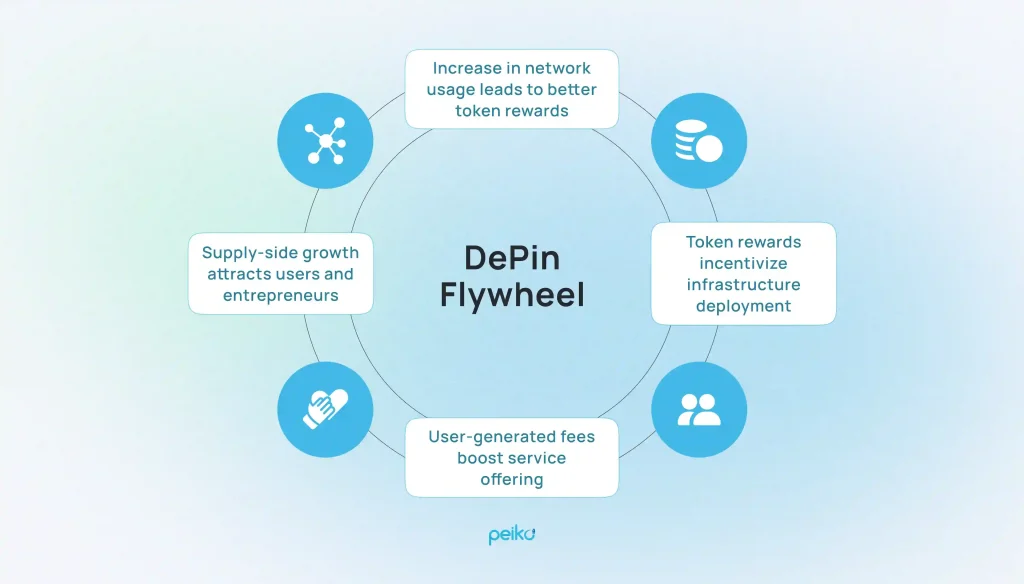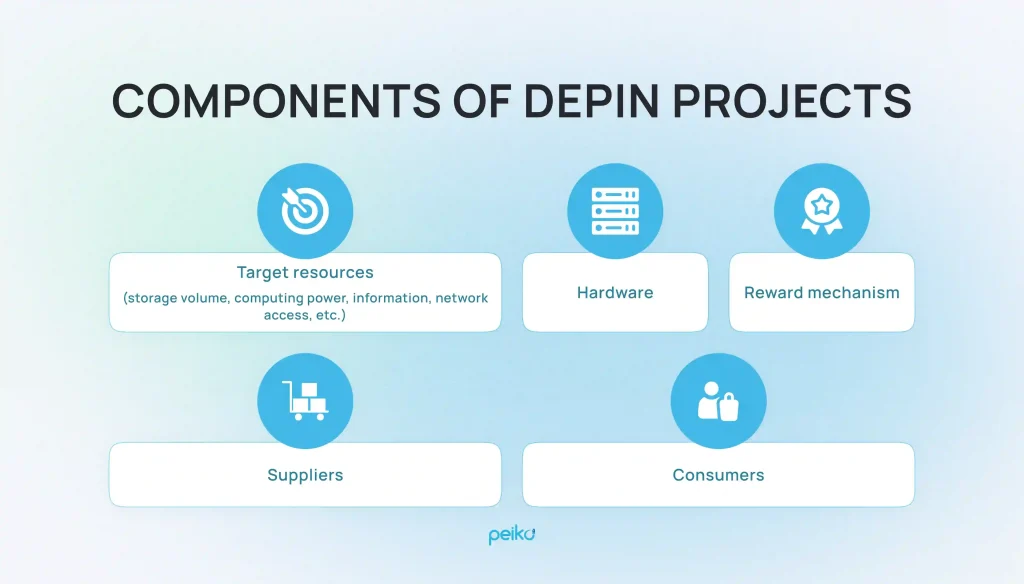Today’s digital era constantly evolves and changes various aspects of our lives. However, one fundamental element – our physical infrastructure – has not kept pace with fast development. This sector is of great importance for social progress and includes integral components such as transport systems, communication networks, and energy networks.
Historically, they have been driven by centralized parties. Although their management and control methods are quite effective, they have some issues. These are stagnation of innovation, susceptibility to system failures, and other significant barriers to entry into the market. This is where a new approach emerged, implying the creation of decentralized networks of physical infrastructure. The new technology is called DePIN.
This concept is an innovative framework based on DeFi (decentralized finance) methodology. It allows the creation of decentralized projects that reward participants for real actions in the physical world.
In this article, we will explore DePIN crypto meaning and its numerous benefits in the context of digital and crypto industries. Let’s begin!
What Is DePIN in crypto?
So, what is DePIN crypto? DePIN meaning lies in the decentralized physical infrastructure network. It is a decentralized network of participants who, using a public registry (blockchain) and cryptocurrency, create and support a specific infrastructure project. Simply put, DePIN crypto involves using blockchain to run and maintain decentralized networks of equipment such as sensors, network devices, physical data storage, wireless infrastructure, energy networks, and more.
Building and operating physical infrastructure networks is expensive and complex and has historically been in the hands of large corporations or states. It is because these infrastructures have the capital and resources. DePIN has come to change this approach to a more transparent system and collective ownership of resources.
The decentralized nature of blockchain, in contrast to CeFi, allows the building of a network based on horizontal connections and not in a hierarchical order, as is usually the case with large infrastructure projects.
DePIN is trying out a long-proven system of rewards for work done in the world of cryptocurrencies to encourage participation in physical infrastructure networks. For active contributions to the project, participants receive project tokens (or, theoretically, another cryptocurrency).
The DePIN flywheel demonstrates how DePIN encourages people to build physical infrastructure networks for other people and machines to use. In this case, people can participate without huge upfront investments like traditional business models.
Let’s look at the diagram below. Tokens attract people to deploy hardware that offers services to other people. Supply-side people make money by providing new or existing equipment to people seeking the goods or services that equipment provides. Since no intermediaries exist, goods and services are often cheaper and faster.

DePIN crypto projects offer voluntary cooperation of participants. Individuals participate in DePIN networks using either their own equipment or purchasing specialized equipment designed specifically for a specific job. The range is very different: from simple hard drives to weather stations. However, as a rule, DePINs are currently built around opportunities available to the general public.
There are two types of DePIN:
- PRN (physical resource networks): PRNs are localized, decentralized networks where providers provide hardware resources on-site (for example, installing a sensor or distributing the Internet). These resources are location-specific, and their contribution to the network varies by location. So, they are not fungible.
- DRN (digital resource networks): DRNs are networks whose providers provide resources based on their function rather than location. Examples of such resources are computing power, bandwidth, and data storage.

How does DePIN work?
DePIN operates on a “token economy” model. This means connecting the demand and supply sides to form a self-propelling cycle. Tokens are used to reward users for installing hardware, providing services or goods in the real world, and compounding on-chain and off-chain data.
Here are the main components and participants of projects that implemented the DePIN technology.

The supplier provides some resources for the network by operating and deploying hardware equipment, receiving a nominal fee for doing so. The requester pays tokens to use the network’s services, enhancing the turnover and value of the tokens. As the network expands, more parties from both the supply and demand sides join in, creating an extended ecosystem.
Advantages of DePIN
The following are the main reasons why end users may choose DePIN over centralized infrastructure models for their computing, wireless connectivity, data storage, artificial intelligence, and services marketplace.
Enhanced security and transparency
DePIN networks work on blockchain, providing the highest security and transparency in all data transactions. In today’s time, when data privacy and security have become crucial concerns, these decentralized systems shift more sensitive control to the owner. No central point of control reduces the possibility of data breach and unauthorized access in DePIN.
Privacy-preserving technologies ensure users can easily transact, knowing their data remains confidential and tamper-proof. In the end, this builds trust among participants who can verify the authenticity of a transaction independently on-chain. Indeed, as more users start using the solutions offered by DePIN, words of increased security and greater transparency will continue to spread, making these networks a better choice than the traditional ones.
Increased security and transparency features:
- Immutable transaction records
- User-controlled data access
- Privacy-preserving technologies
- Independent verification of transactions
- Reduced risk of hacking and fraud
Scalability and resilience
The main distinctive feature of DePIN networks is their scalability and robustness. Their capacities grow with the number of new participating independent nodes. Such a decentralized architecture makes infrastructure easily scale up to match changing loads. Unlike most systems prone to chokepoints when many users operate them, DePIN can maintain consistent service levels across the board.
Moreover, without any central authorities, DePIN networks are less susceptible to single points of failure. For instance, recent outages of major centralized services have demonstrated the fragility of traditional models. On the contrary, the structure of DePIN enforces resilience through redundancy: if one node fails, others keep up the work, hence guaranteeing continuous service. This reliability is important for users who depend on seamless connectivity and access in their daily activities.
Lower costs and efficient resource allocation
DePIN significantly decreases the costs of such systems by making access to many users feasible without deterring investment in heavy machinery and professional technology. The cost-effective architecture is even more supplemented by options for decentralized data storage offered by DePIN, which as a rule become considerably cheaper than their traditional counterparts.
Another compelling advantage is the efficient allocation of resources. While the network continues to grow, funds that would typically go to the maintenance of the central servers can be transferred to the betterment of services and support for the users. Above all, the financial benefits make DePIN a better fit for individuals and businesses hoping to leverage emerging technologies without too much financial strain.
The industry’s lack of regulation may also contribute to the use of crypto DePIN projects for illegal purposes, such as storing illegal content.
Key components of DePIN
Decentralized Physical Infrastructure Networks are powered by a number of crucial components in regard to their functioning. Each component is designed to significantly contribute to the efficiency, security, and ease of operation in decentralized systems. Now, let’s take a closer look at the key building blocks that make DePIN such a unique concept.
Blockchain technology
The backbone of DePIN is blockchain technology, which offers a decentralized and transparent record-keeping ledger system for every transaction made. That ensures data recording is done securely and, importantly, verifiable without reliance on central authorities.
It helps further increase trust among its users by reducing fraud and manipulation. Immutability is thus guaranteed, as the integrity of data is an assurance, therefore making it indispensable in any DePIN project. Transparency of information sharing gives participants confidence that their contributions are secured in an imposing network.
Smart contracts
Smart contracts are basically agreements executed autonomously in code form. They enable smooth interactions, such as those dealing with transactions and rewards, through trustless methods by automating their execution. Smart contracts make it easier to have a better flow of operations inside DePIN because most intermediary steps have been eliminated.
Digital contracts operate themselves for the facilitation of smooth execution when the set conditions have been met to cut down delays and eliminate disputes. Because they are programmable, this therefore makes handling complex agreements within decentralized networks much easier. It opens up the frontiers for innovative financial ecosystems as well as for modern approaches to scientific legacy.
Tokenization
Tokenization transforms tangible assets into digital tokens that can be seamlessly traded and owned by multiple owners. It democratizes access to resources by enabling participation in hitherto inaccessible markets.
The idea of tokenization in DePIN introduces fractional ownership possibilities, making high-value assets more affordable than having to incur full costs. Additionally, the process of tokenizing assets on the blockchain means ownership is more transparent and secure, thus fostering trust among participants.
As these components further develop, they will no doubt continue to lead the way into a more inclusive and collaborative future, reshaping our interactions with physical infrastructures.

What are the challenges facing DePIN?
While blockchain technology impacts positively enhanced security and privacy in the digital realm, its implementation is not without hurdles. Specific issues must be solved to integrate DePINs successfully into existing systems. Below are some of them:
Adoption stage and impact on revenue
One of the primary challenges facing DePIN is the adoption stage, which can profoundly influence revenue generation. Many potential users may be hesitant to transition from traditional systems to decentralized models, fearing complexity or unfamiliarity. This slow adoption can directly affect the platform’s revenue streams, limiting the growth potential. Effective marketing strategies and user education about the benefits of DePIN are crucial to overcoming this challenge.
Technological complications
Implementing DePIN can introduce technological complications, particularly when integrating with existing systems. The process may require significant technical expertise, especially regarding the migration of data to decentralized frameworks. Additionally, the complexity of maintaining decentralized networks can become a barrier to entry for smaller businesses or individuals with limited resources, making it imperative to streamline technology for broader accessibility.
Cost of running private facilities
The cost of running private decentralized facilities can be prohibitive. While DePIN crypto projects promise lower operational costs, initial expenditures may still be high, particularly for startups. Investing in hardware, software, and infrastructure can create a financial burden. This challenge raises concerns about the financial viability of operating DePIN solutions, especially in a market that demands competitive pricing.
Profitability
Achieving profitability in the decentralized model can be challenging due to various factors, including competition and market saturation. DePINs must find innovative ways to generate revenue while providing value to users. Balancing operational costs with user incentives and tokenomics is essential to ensure that the platform remains sustainable while also attracting and retaining a loyal user base.
Overcoming these challenges will be critical for the successful implementation of DePINs and realizing their full potential to revolutionize digital identity verification.
DePIN sectors and DePIN crypto projects
The nascent DePIN industry includes more than 250 projects. They undertake decentralization to ensure systems across several industries are more effective, accessible, and resilient. Some of the most interesting areas and projects in the DePIN ecosystem are as follows:
Wireless
DePIN projects in the wireless sector make wireless decentralized, owned, contributed to, and participated in directly by the users. Projects such as Helium allow individuals to create hotspots themselves and get tokens for providing coverage, turning local connectivity into a shared community resource.
Geospatial
In the geospatial industry, DePIN allows for decentralized mapping and location-based services. These projects securely and transparently share data enabled by blockchain for various applications in everything from logistics to urban planning.
Mobility
DePIN in mobility concerns itself with the aspect of decentralized transportation networks, encouraging shared mobility solutions, including ride-sharing and autonomous driving. By introducing token economics into the projects, the projects incentivize users for active participation in sharing data that contributes to better functionality in transportation systems.
Health
Health-related DePIN projects seek to further decentralize the management of health data by the patient. These platforms allow better access to healthcare while improving patient outcomes through privacy and secure sharing.
Energy
The energy sector is embracing DePIN through peer-to-peer energy trading and decentralized energy production. Projects like Power Ledger enable the buying and selling of renewable energy among its consumers, furthering sustainability and energy independence.
Storage networks
DePIN projects are building decentralized storage solutions that allow users to rent extra space on their devices for data storage. The solution will reduce reliance on centralized data centers, hence offering more security and cost efficiency in meeting data storage needs.
Compute networks
DePIN focuses on compute networks that decentralize the processing power for applications. The computing resources of people can be tapped into by these networks, enabling efficient execution of tasks at lower costs for the users.
Bandwidth networks
Bandwidth networks are DePIN projects that allow users to share their unused internet bandwidth, therefore creating decentralized and efficient network infrastructure. This novelty further improves access and increases the equity of connectivity resource distribution.
As these projects continue to develop, they hold great potential for drastically changing everyday life: making technology more available, safer, and community-oriented. The future of DePIN is bright, with endless possibilities for innovation across various fields. Let’s concentrate more on it.
The future of the DePIN technology
DePIN has a rare commodity in the cryptocurrency sector: real-world utility. Its services, such as wireless communications and cloud computing, are poised to draw demand from diverse industry areas, comprising gaming, media, or PoW (proof-of-work) mining. Notably, many DePINs can compete with centralized technology enterprises, not the established financial organizations and central banks that decentralized finance is aiming to supersede.
DePINs are not reinventing the wheel. They are making decentralized open markets for the same services that traditional tech firms provide. Let’s consider the prospects of DePIN technology:
- Research of new business scenarios: The development of the DePIN direction will contribute to researching additional business scenarios and models. Projects can utilize both Web3 and Web2 technologies to unite together diverse manufacturers, services, and device ecosystems on a “neutral territory.” Such a combination will lead to more innovative and sustainable business models.
- Focus on expanded adoption: DePIN can bring a decentralized physical infrastructure network to the population. With time, DePIN is forecasted to become a user-centric app layer. This will drive wider adoption of blockchain technology, allowing everyone to receive more decentralized and efficient services.
- Integrating IoT needs: The thriving of DePIN will depend in part on understanding IoT requirements. With the development of the Internet of Things, DePIN is projected to better meet the worldwide demand for IoT services (sensor networks, location data) and drive the development of the field.
- International collaboration: To build a worldwide, decentralized network, the DePIN technology may reinforce international collaboration and create a global network ecosystem. This will allow better responses to global requests, simplify the exchange of experience and technology, and promote the development of DePIN in a more transparent way.
- Clearer industry rules: As DePIN progresses, the requirement for industry rules will become more essential. Regulators and governments can emphasize compliance with DePIN and develop a more explicit regulatory framework in this area. This will lead to the long-term promotion of the technology and its stable growth.
- Optimization of the token reward model: This model is one of the main mechanisms used in the projects that implemented the DePIN technology. In the next years, the reward model can be optimized to engage more users to participate and create a profitable cycle. Token incentives form the basis for the sustainable development of DePIN.
As an innovative and forward-looking technology, DePIN has ample growth opportunities and demonstrates impressive potential for the future.

Blockchain development project? Peiko’s the first to master
At Peiko, our team comprises seasoned experts providing top blockchain development services. We deliver solutions that end-users like due to their modern and user-friendly design, great performance, and enhanced security. Visiting our site, you can see our portfolio, which includes many successful cases like Riabu or Bitcoin Additional, and reviews from satisfied business owners.
For example, Bitcoin Additional is one of the best blockchain projects we worked on. It is a functional and convenient crypto wallet that operates with diverse coins, includes the synchronization of users’ contact books, and provides an offline payment function.
The main task was to make this solution extra-secure, as a cryptocurrency wallet should be to be trusted among users.

So, we implemented industry-leading security standards to safeguard users’ assets. To achieve this, we integrated robust processes throughout the application life cycle to swiftly identify and rectify vulnerabilities. We also conducted routine security audits to ensure the integrity of the source code.
Bitcoin Additional has now amassed thousands of users, attesting to its reliability and security standards.

With Peiko as your development partner, you can be assured that your project will be in capable hands and backed by a team of dedicated professionals.
Whether you’re aiming to integrate DePIN blockchain technology into your established systems, want to create a DePIN crypto project, or, for example, need decentralized exchange development services, we will help you every step of the way.
Conclusion
Now, you have grasped the DePIN crypto meaning. DePIN blockchain projects are pushing the boundaries of traditional infrastructure models, offering excellent scalability, efficiency, and interoperability. Implementing decentralized infrastructure may take some time as DePIN faces challenges that have yet to be resolved. Still, this modern technology has all chances to modify the future of diverse industries, from finance to supply management, healthcare, and others.
If you need an innovative blockchain solution that attracts users, the Peiko team is here to help you, just contact us. Let’s collaborate and implement your vision to life!
No comments yet. Be the first to comment!











